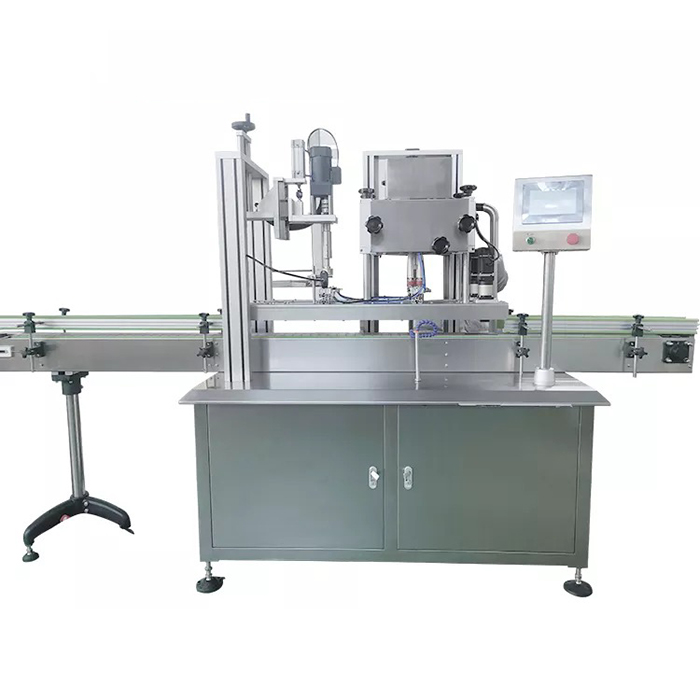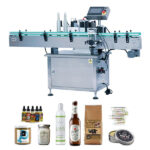In equipments, a spindle is a rotating axis of the machine, which often has a shaft at its heart. The shaft itself is called a spindle, the word often is used metonymically to refer to the entire rotary unit, including not only the shaft itself, but its bearings and anything attached to it.
The following is the spindle device of common spindle capper:
What is a Spindle Capper?
The spindle capper uses sets of "spindles" or rubber discs that spin a cap down tightly on threads to seal the container (Most spindle cappers will use three or four sets of spindle wheels to tighten down the caps). Automatic capping machines use a cap delivery system such as a cap elevator or vibratory bowl, while semi-automatic machines will usually require hand placement of caps before tightening.
Application of Spindle Capper
Spindle cappers can tighten and torque most types of threaded caps onto most kinds of bottles, and the caps can range in size from 8 mm to 110 mm. The types of caps these machines can handle include:
- Flat caps
- Oval caps
- Flip top caps
- Pull spouts
- Safety caps
- Childproof caps
- Sport caps
- Caps with over-caps or induction seals

Nearly any type of bottle type or shape can be used, and they can be made from materials that include PET, PP, PVC, HDPE, LDPE and glass. The bottle heights can range from 1” to 14”. Containers with odd shapes can be handled with dual gripper belts.
How Spindle Capper Work?
The spindle capper does two things:
- Organize and dispense caps.
- Tighten the cap on its container.
Preparing the caps.
Before the capper can receive the bottles, first the caps already have to be set in place. The process can be automated with different optional cap sorting devices: vibratory bowls, which use vertical vibrations to position caps in an energy-efficient way; centrifugal bowls, which place caps into position by means of a spinning motion; or a sorting elevator, where the caps that are correctly placed travel up on a revolving belt, and the ones that are not pop off. The caps can be positioned by hand as the bottles are placed on the conveyor. Depending on the level of automation in place, this can be as easy as emptying a container of caps into a chute.
Holding the parts steady.
Just a small misalignment can cause the caps to jam, so the spindle capper has to stabilize both the bottles and the caps as they pass through the spinning disks. This is done with tool-less gripper side belts on both sides of the bottles that keep them upright and in the proper position, and cap stabilizers that put just enough pressure on the caps to keep them from falling off until they are introduced to the tightening process.
Tightening the caps.
The capper then tightens the caps onto the bottles using 4, 6 matched spinning disks (spindle wheels). The bottles go straight through until the correct amount of torque is applied.
Easy adjustments.
The settings can be adjusted to accommodate different jobs. You can change the torque, spindle wheel position, and gripper belt height and width. The team at VKPAK is also on hand to help you find the best combination for each capping need.
Working Video

What we offer Spindle Capper
VKPAK spindle cappers provide a highly versatile solution for applying and tightening threaded caps. The spindle capper is the core of an automated system when integrated with our vibratory or centrifugal sorting bowl, or with the elevator-style cap orientor. We manufacture our automatic capper for liquid packaging lines here in our facility. It is flexible, durable and works with most containers and caps including flat caps, sport caps, metal lids and many others.

Spindle Capper Theory of Operation
The spindle capper is probably the most popular automatic capping machine for screw type caps. This capper receives bottles with caps already set in place and then automatically tightens the caps using several sets of matched spinning disks, or spindle wheels. The capping process will run continuously without bottles stopping for indexing, cap placement or any other reason.
Of course, in order to remain consistent and reliable, the spindle capper must stabilize the bottle as it passes through the disks that will spin down the screw cap. Gripper side belts and cap stabilizers hold the caps and bottles in place as they move through the capping machine. The gripper belts will be used on the side of the bottle to keep it upright and in position during the capping process. Some applications will require a capping machine with double gripper belts to keep tall or odd shaped bottles stabilized. The cap stabilizer will keep pressure on the top of the cap from placement on the bottle to (at least) the point where the bottle and cap are introduced to the spindle wheels.
Most spindle cappers will use three or four sets of spindle wheels to tighten down the caps. The last set of spindles will normally include clutches that allow for just the right amount of torque to create a dependable seal on the bottle. As noted above, the bottles run continuously through the capping machine. This is made possible on the automatic machine through the use of a sorting elevator or sorting bowl that will automatically deliver caps to the capping machine. The automatic cap delivery system means that the operator of the capping machine or packaging line need only replenish bulk caps on occasion.
Changeover on the capping machine will normally consist of simple hand adjustments to the cap chute, the height and width of the spindle wheels and gripper belts and some adjustment to the elevator or bowl. In some cases, where a wide variety of caps are being run on one machine, some tool based changes may be necessary, such as changing out a stabilizer or adding a second gripper belt.
The spindle capping machine will work with numerous types of screw caps as well. From simple flat caps to sports caps to trigger sprayers and other unique screw type caps, this capping machine offers both versatility and efficiency for a wide range of industries.
Spindle Capper Set Up and Adjustments
While it is true that spindle cappers will normally be set up at the factory or during installation for customer specific bottles and caps, there are good reasons for operators to understand the basics of that set up, including but not limited to relocation of machinery or introduction of new bottle and cap combinations. Below are a few of the basic tasks involved in setting up a spindle capping machine for automatic production.
Operate Video

Leveling The Conveyor
Before even beginning to set up the spindle capping machine, packagers must first place and level the conveyor system on the production floor. Without a level system to transfer bottles through the capping area, operators will find it nearly impossible to get a reliable, consistent seal from the machine. Once the conveyor is in place on the plant floor, leveling legs will allow for adjustments until the conveyor is level.
Leveling And Aligning The Capper
Just as the conveyor must be leveled, so must the spindle capper. But first, the capping machine should be rolled up to the conveyor, typically aligned so that the spindles are centered over the conveyor belt. (Exceptions do exist for custom applications or where odd shaped containers are used.) Once in place, level the capping machine just like the capper, using the leveling legs to make adjustments. In the end, a bottle can be used, sliding it through the capping area, to check alignment.
Setting The Height Of The Capper
Adjusting the height of the spindle capper generally adjusts the housing, which includes the spindle wheels. The height of the spindle wheels are important simply because if the wheels are not set to contact a stable part of the cap, the machine will not produce consistent seals. The ideal spot on the cap will differ with the type and size of the closure being used, but operators want the wheels to contact at a spot that will allow torque without affecting stability. Of course, a stabilizer bar will also be used to help ensure consistent seals as well.
Adjusting Spindle Wheel Width
Spindle wheels can be moved in and out using simple hand knob adjustments on the face of the machine. Getting just the right pressure on the caps as it passes through the spindle wheels can take a little bit of trial and error, as slight adjustments can affect performance. If wheels are too tight, damage may result to the cap and bottle or operators may experience cross threaded caps. Wheels that don't apply enough pressure may result in inconsistent seals or no sealing at all. The best way to set the width is to simply perform test runs making slight adjustments while paying attention to the tell-tale signs of improper alignment noted above.
Adjusting Gripper Belts
Gripper belts stabilize and steady the bottles as they move through the capping area. Simple hand cranks will allow for adjustment both up and down as well as in and out, allowing the machine to accommodate a variety of bottle shapes and sizes. These belts need to touch the bottles without squeezing them to allow free but stable movement. Tight gripper belts may restrict movement and cause jams or spills, while loose belts can lead to shaking, tipping and inconsistent capping.
Other settings for spindle capping machines include adjustment to the cap chute, fingers and stabilizer bar, though most issues can be resolved by the adjustments noted above. Again, small adjustments to the spindle capper can lead to drastic changes in performance, which is why the machinery is prepared at the factory or during installation.
Advantages of Spindle Capper
While many different cap types exist for those packaging a product, the screw cap is probably still the most popular. Screw caps themselves can take on a number of different shapes and forms, from simple flat caps, to flip top caps, sports caps and even trigger sprayers. And while different capping machines exist for screw caps, the spindle capping machine continues to be the capper of choice for those running automatic packaging systems.
Spindle capping machines use sets of matched, spinning wheels to apply torque to the screw caps as they pass through the capper. A spindle capper may also use a clutch on the last set of spindles to allow for more accurate and consistent torque. Gripper belts support bottles as they move through the capping area, guarding against stripped and missed caps as well as bottle tipping and product spilling. There are several other advantages that make spindle cappers popular among packagers that use a screw cap to secure their bottle.
1. Continuous Capping
Spindle cappers allow for continuous capping on a packaging line. By using cap elevators, vibratory bowls or even a combination of the two, the operator of a spindle capping machine need only replenish bulk caps from time to time. The elevator and/or bowl deliver caps to a cap chute, which in turn delivers caps to the bottles. Each bottle receives a cap just prior to entering the capping area, keeping the process continually moving forward.
2. Fewer Wear Parts
The wear parts on these capping machines are limited as well. The spindle discs which will contact the cap and the gripper belts which stabilize the bottle are the two components of the spindle capping machine that a packager can expect to replace over time. The capper parts are affordable enough that most packagers simply keep replacement discs and belts on hand, avoiding extended downtime and ensuring efficient production.
3. Easy Changeover
Spindle cappers do not normally require any type of change parts for different bottles or caps. Though some adjustments may be necessary - to the chute, gripper belts and/or discs - these adjustments can be made on the capper control box, capper face plate or through the use of simple fingertip knob adjustments. The easy changeover from one bottle to another reduces downtime and keeps production moving even when multiple bottles or caps are being used in the same packaging plant.
4. Range Of Bottles And Caps
The easy changeovers allow the spindle cappers to efficiently run a wide range of cap types and sizes. As mentioned above, screw caps come in many forms. The spindle capper can handle a sports cap, flat cap, trigger sprayer or any other type of screw cap. In addition, spindle capping machines can handle different bottle types and sizes as well. From skinny round bottles to larger square bottles, and even F-style containers, a few simple width and height adjustments and the spindles will be applying torque once again.
5. Torque Control Through Clutches
Finally, as we have already noted as well, spindle capping machines can use clutches on a single set of spindle wheels to ensure the consistent application of torque. By avoiding caps that are too tight or too loose, a packaging company can avoid problems as simple as a product spill to those as complicated as bad publicity or even a product recall. This peace of mind, coupled with all the other advantages of the spindle capper, is what keeps the spindle capper such a popular capping machine.











